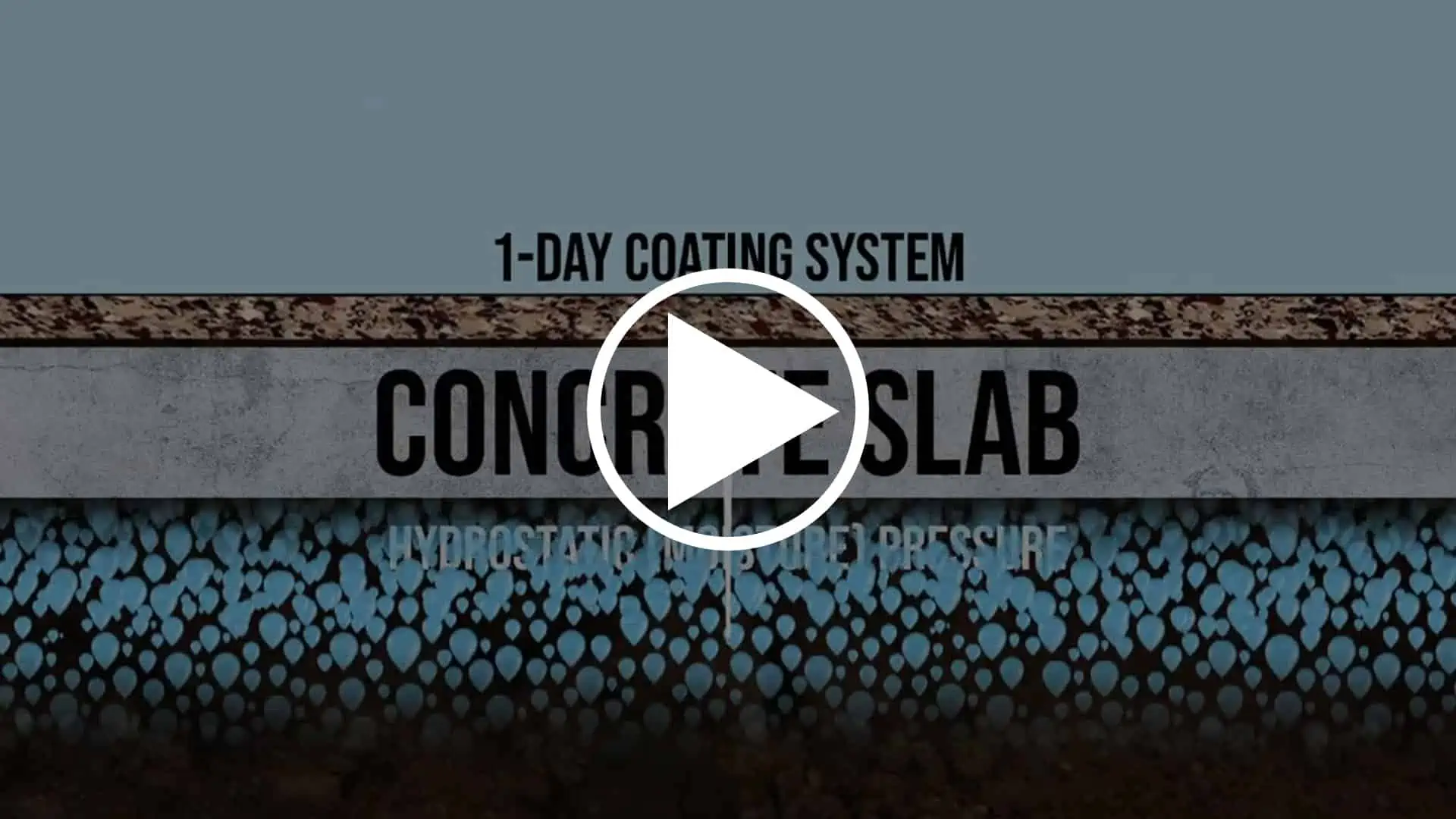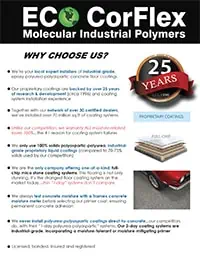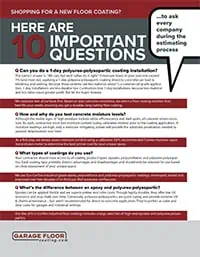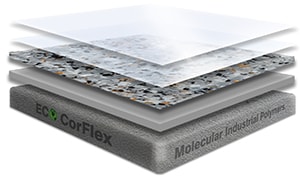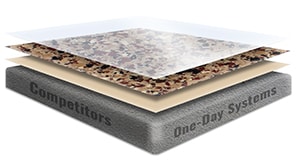UNVEILING THE REALITY OF “SINGLE-DAY” CONCRETE COATINGS
In an article by GarageFloorCoating.com, authored in August 2020, titled “Polyurea-Polyaspartic One-Day Systems: Do They Work“, GarageFloorCoating.com unveiled the reality of sub-standard, “single day” concrete coating systems. The popularity of “1-day polyurea” or “1-day polyaspartic” garage floor coatings has risen sharply with contractors because of the simple application process and product and labor savings. Customers also like these systems because they only take one day to install. But like most things in life, what may seem too good to be true, often is. Caveat emptor…”Let the buyer beware”.
Polyureas VS Polyaspartics
In the concrete coating industry, quick-curing liquid coatings called polyureas and polyaspartics are well used. Aside from their quick-cure capability, these liquid coatings provide exceptional UV (sunlight), chemical, stain, abrasion and impact resistance. These properties make polyureas and polyaspartics indispensable. But what’s the difference between the two coating types?
While it’s common to hear “polyurea” and “polyaspartic” used interchangeably, these two coatings do differ in both their chemical composition and cure time. “Pure” polyureas (used to coat truck beds, for example) can harden within seconds. Because of this rapid cure rate, specialized equipment (like portable reactors) is typically required. Applicators applying these products to concrete floors need to have something that cures a little slower…something that allows the applicator to use a regular roller or squeegee to manually apply the coating. So chemists went about modifying “pure” polyureas to create slower-curing products called aliphatic polyureas…another name for an aliphatic polyurea is a “polyaspartic”. Although slower curing than a “pure” polyurea, polyaspartics are still considered quick-curing coating types relative to, say, an epoxy or polyurethane.
Polyureas & Polyaspartics – One Significant Drawback
Though polyurea-polyaspartic coatings possess incredible benefits, they have one significant drawback – they simply aren’t suitable for direct-to-concrete application (ask an architect) and should never serve as a primer coat…especially under medium to high-moisture concrete conditions. The way that a polyurea-polyaspartic cures prevents them from being able to be applied thickly…only thin to moderate coats are possible (a thick coat won’t cure properly). As moisture wicks up through porous concrete in a process called moisture-vapor transmission, hydrostatic pressures build, pushing up against the primer coat. The wafer thin coat of a polyurea-polyaspartic will start to peel (delaminate) if these pressures exceed their ability to withstand the upward forces. This is a common problem with systems that use a polyurea-polyaspartic direct-to-concrete!
Of course, contractors using a polyurea-polyaspartic as primer in “one-day” systems will contest this, but their warranties show their hand. All “1-day polyurea” and “1-day polyaspartic” coating systems have warranty exclusions for “moisture-related issues” (like high hydrostatic pressures) in their small print. Many have warranty exclusions to staining!
If the “1-day” guys were so confident in their flooring, why won’t they fully warrant moisture and staining?
How Do Expert Installers Deal with Moisture?
Expert installers circumvent potential moisture issues (and the resulting delamination) by employing a moisture-mitigating epoxy as the primer coat…never a polyurea-polyaspartic direct-to-concrete. They reserve the fast-curing polyaspartic as a final clear topcoats only. Contractors who promise “one-day” applications can’t follow this method of application, because using a slower-curing epoxy would force the installation duration beyond 1 day (to 2). Therefore, during the sales pitch, the “1-day” guys discredit epoxies (because they only have polyurea-polyaspartics at their disposal) and fail to explain that each coating type has its strengths and weaknesses.
Cue the Epoxy
Epoxies cure differently. The greater the epoxy mass (that is, the thicker it is), the faster it cures. This is why epoxies are called “high-build” coatings – they can be applied very thickly. Because of this, moisture-mitigating epoxies act as superb concrete primer coats; they can be applied in thick layers that resist high hydrostatic pressures. However, epoxies do have a weakness…they may not serve well as topcoats due to their tendency to chalk and fade when exposed to UV light (sunlight). So epoxies are great as primer coats and lousy as topcoats (if exposed to UV light).
Conversely, polyurea-polyaspartics act as exceptional topcoats, but fall short when used directly on concrete because they only permit thin applications, and these ultra-thin coats can’t withstand high hydrostatic pressures! Your installer should have all coating types at their disposal – epoxies, polyurethanes, and polyurea-polyaspartics – and use them in a way that maximizes the strengths of each type. An epoxy isn’t better than a polyurea-polyaspartic…and a polyurea-polyaspartic isn’t better than an epoxy. Just like Windex isn’t better than Javel…they’re both excellent products if they are used in the right way.
The “1-day” system contractors have had to “adjust” so they can stick with their “one-day” promise by using polyurea-polyaspartics as both primers and topcoats. Unfortunately, they’ve adjusted by including warranty exclusions in their customer contracts. These exclusions include “moisture-related issues”, and in some cases, staining from hot-tire transfer…two of the most common reasons for coating system failure! But if delamination does occur, the 1-day provider gets to dodge accountability simply by invoking the warranty exclusions.
Our Coatings VS the 1-Day Coatings
To build our floors, we leverage the unique strengths of both epoxies and polyaspartics. Our primer coat is a moisture-mitigating 100%-solids epoxy (not a polyurea-polyaspartic). We then broadcast your chosen flake blend…and you can select from over 50 vibrant full-flake color combinations. The final touch entails, not one, but two coats of our 100%-solids clear polyaspartic topcoat. In total, our coatings measure over 35 mils in thickness – and due to our application process – resists moisture (including high hydrostatic pressures), staining (including hot-tire transfer) and staining from most automotive fluids. We include no warranty exclusions for “moisture-related issues” or staining of any kind!
If this isn’t enough, here are more reasons our flooring surpasses any “1-day” installation:
- Our full-flake garage floor coatings only use industrial-grade,100%-solids liquid coatings
- As discussed, we only apply a thick, moisture-mitigating epoxy primer direct-to-concrete
- We go beyond conventional thermoplastic flake bends, offering mica stone-infused blends (with over 30 choices)
- We finish our full-flake garage floor coatings with two coats (not just 1) of our clear 100%-solids polyaspartic
- We offer a comprehensive guarantee for issues related to moisture and staining (no hidden clauses)
Are you seeking long-lasting, professional-grade coatings for your garage floor that come with a genuine guarantee? Contact us at GarageFloorCoating.com of Phoenix at (602) 368-2669 to arrange a complimentary, on-site quote.

